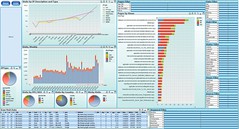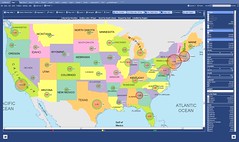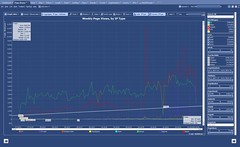Monitoring
Archived Posts from this Category
March 29, 2014
Observing and comparing multiple (similar) multidimensional objects over time and visually discovering multiple interconnected trends is the ultimate Data Visualization task, regardless of specific research area – it can be chemistry, biology, economy, sociology, publicly traded companies or even so called “Data Science”.
For purposes of this article I like the dataset, published by World Bank: 1000+ Measures (they called it World Development Indicators) of 250+ countries for over 50+ years – theoretically more then 10 millions of DataPoints:
Of course some DataPoints are missing so I restricted myself to 20 countries, 20 years and 25 measures (more reasonable Dataset with about 10000 DataPoints), so I got 500 Time Series for 20 Objects (Countries) and tried to imitate of how Analysts and Scientists will use Visualizations to “discover” Trends and other Data Patterns in such situation and extrapolate, if possible, this approach to more massive Datasets in practical projects. My visualization of this Dataset can be found here:
In addition to Trends Line Chart (please choose Indicator in Filter at bottom of the Chart, I added (in my Tableau Visualization above) the Motion Chart for any chosen Indicator(s) and the Motion Map Chart for GDP Indicator. Similar Visualization for this Dataset done by Google here: http://goo.gl/g2z1b6 .
As you can see below with samples of just 6 indicators (out of 1000+ published by World Bank), behavior of monitored objects (countries) are vastly different.
GDP trends: clear Leader is USA, with China is the fastest growing among economic leaders and Japan almost stagnant for last 20 years (please note that I use “GDP Colors of each country” for all other 1000+ indicators and Line Charts):

Life Expectancy: Switzerland and Japan provide longest life to its citizens while India and Russian citizens are expected to live less then 70 years. Australia probably improving life expectancy faster than other 20 countries in this subset.

Health Expenditures Per Capita: Group of 4: Switzerland, Norway (fastest growing?), Luxemburg and USA health expenses about $9000 per person per year while India, Indonesia and China spent less then $500:

Consumer Price Index: Prices in Russia, India and Turkey growing faster then elsewhere, while prices in Japan and Switzerland almost unchanged in last 20 years:

Mobile Phones Per 100 Persons: Russia has 182 mobile phones per 100 people(fastest growing in last 10 years) while India has less then 70 cellular phones per 100 people.

Military Expenses as Percentage of Budget (a lot of missing data when it comes to military expenses!): USA, India and Russia spending more then others – guess why is that:

You can find many examples of Visual Monitoring of multiple objects overtime. One of samples is https://www.tradingview.com/ where over 7000 objects (publicly traded companies) monitored while observing hundreds of indicators (like share prices, Market Capitalization, EBITDA, Income, Debt, Assets etc.). Example (I did for previous blog post): https://www.tradingview.com/e/xRWRQS5A/















